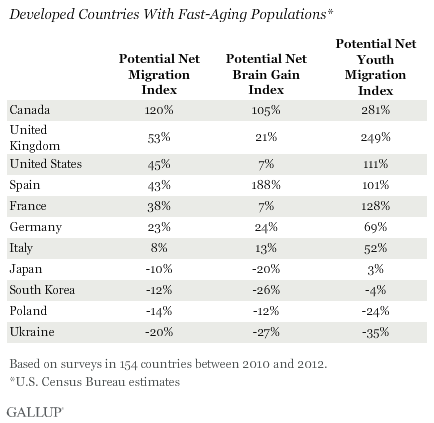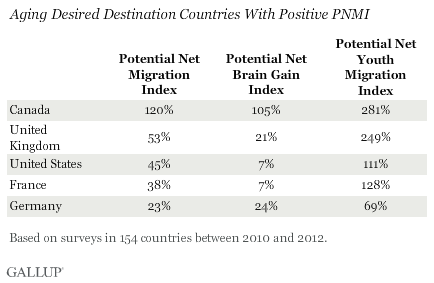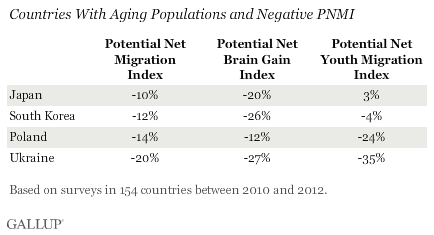This article is part of an ongoing series analyzing how baby boomers -- those born from 1946-1964 in the U.S. -- behave differently from other generations as consumers and in the workplace. The series also explores how the aging of the baby-boom generation will affect politics and well-being.
Story Highlights
- Aging countries such as U.S. good at attracting young people
- Potential Net Migration Index for Japan is -10%
- Canada attracting young and educated
WASHINGTON, D.C. -- If everyone around the world who wanted to move actually moved where they wanted, many developed countries where workers are aging faster than they are being born would see an influx of people, and this could help fill their shrinking labor pool. Gallup's Potential Net Migration Index suggests the resulting migration would inject much-needed youth into the workforces in many of these countries, but not all.

These results are based on Gallup surveys of the migration desires of nearly 520,000 adults in 154 countries between 2010 and 2012. Gallup created three indexes -- the Potential Net Migration Index, Potential Net Brain Gain Index and Potential Net Youth Migration Index -- to gauge the likely changes to the population if people who say they would like to migrate permanently actually move where they want. The higher the index score, the larger the potential net population gain. Negative scores indicate net population loss.
The Potential Net Migration Index measures the total potential net change to the adult population by subtracting those who would like to move out of a country from those who would like to move into a country. The Potential Net Brain Gain Index is calculated with a similar approach and measures the potential net change to the adult population with four or more years of education after high school or the equivalent of a bachelor's degree or higher. The Potential Net Youth Migration Index measures the net change to the 15- to 29-year-old population.
While the U.S. working age population has a large number of aging baby boomers, the populations in a host of other developed countries -- including the United Kingdom, France, Italy, Germany, Spain, Japan and Canada -- are aging faster, and their fertility rates are down. Past migration levels in several of these countries -- many of which are top desired destination countries for migrants -- so far have been enough to stem population decline overall and in the working age population. But without migration or another baby boom, in coming decades, all of these countries might need to raise their retirement ages well past where they are now, meaning employees could be working well into their mid- to late-70s.
Top Desired Destinations With Aging Populations and Positive PNMI
PNMI scores in top desired destination countries such as the U.S., the United Kingdom, Canada, France and Germany are all in positive territory, which means that more adults would like to come to those countries than leave them. But while each of these populations hypothetically would see their youth populations bloom, based on their Potential Net Youth Migration Index scores, they would not see a similarly large influx of educated workers, based on their Potential Net Brain Gain Index scores.

Based on their scores, Canada is more attractive to more educated potential migrants than the United States is. This may reflect Canada's appeal to these groups with its programs for new migrants that focus on language and job training. But this is consistent with earlier Gallup research that shows the U.S. appeals more to the youngest and least educated potential migrants, while those who choose Canada are, on average, slightly older and more educated. These differences may partly reflect the emphasis each country's immigration policy places on different categories of migrants.
Japan, Poland and Ukraine Have Aging Populations and Negative PNMI
Not all countries with aging workforces and dropping fertility rates are magnets for potential migrants. In Japan, for example, which is aging faster than any other country in the world, the PNMI is -10% -- which means its population would actually shrink if all potential migrants moved where they wanted. The country could potentially see a slight boost to its youth population of 3%, but those with more education are more likely to want to leave Japan than come to it (-20%).

Although Japan would seemingly be an attractive destination for migrants as the world's third-largest economy, the country's negative PNMI likely reflects its status as a relatively homogenous society with tight immigration controls. Japan is likely to consider immigration as a last resort to help stabilize its population, but even if it wanted to pursue that route, its PNMI score suggests it would have some work to do to change perceptions.
Bottom Line
International migration can possibly help ease the woes of countries faced with an aging and shrinking workforce and declining fertility rates. While Gallup's PNMI does not predict migration patterns, it does provide useful information about who these countries are attracting around the world and the areas where they need to work to ensure they retain the talent already at home.
Survey Methods
Results are based on telephone and face-to-face interviews with 519,108 adults, aged 15 and older, in 154 countries from 2010 to 2012. The 154 countries surveyed are home to more than 98% of the world's population. In Gulf Cooperation Council countries, only Arab nationals and Arab expatriates were surveyed. PNMI scores for countries where non-Arab expats make up more than 50% of the adult population are not reported: United Arab Emirates, Bahrain and Qatar. Index scores are not reported for countries where total sample sizes are 500 or lower because of the volatility in the index as measured by the margin of error: Jamaica, Northern Cyprus, Suriname and Trinidad and Tobago.
For most countries, aggregated sample sizes (across multiple years of surveys) range between 3,000 and 6,000 interviews. A total of 19,598 interviews were conducted in India, 8,018 in China and 9,000 in Russia.
The PNMI is measured on a scale of -100 (meaning the total adult population of the country would leave) to infinity (meaning the potential inflow of adult population to the country is unlimited and depends on the number of adults who want to move in from around the world). As with any survey-based estimate, the PNMI has a corresponding margin of error for each country, calculated using the standard error of the index. Sample size, size of the country and range in population projection weights affect the PNMI margin of error.
For example, the PNMI for El Salvador is estimated at -33%, meaning if all adults who desire to move in and out of the country did so, the adult population would decline by 33%. With the margin of error at the 95% confidence level, this estimate ranges from -36% to -30%.
Gallup's PNMI is based on responses to the following questions:
Ideally, if you had the opportunity, would you like to move permanently to another country, or would you prefer to continue living in this country?
(If "would like to move permanently to another country") To which country would you like to move? [open-ended, one response allowed]
For more complete methodology and specific survey dates, please review Gallup's Country Data Set details.
Learn more about how the Gallup World Poll works.

